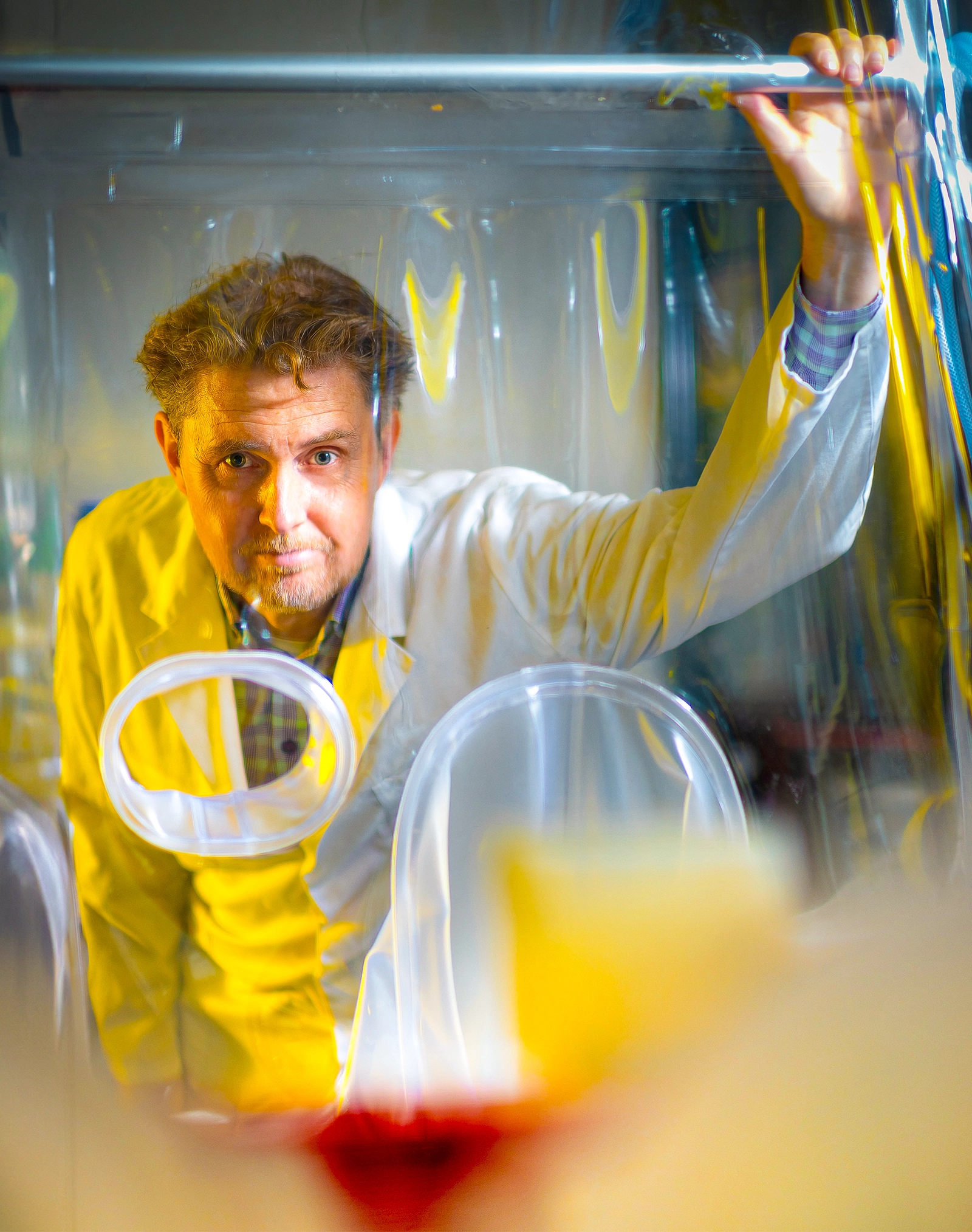A Cell So Minimal That It Challenges Definitions of Life

A cell that lacks any metabolic genes is a new addition to the spectrum of life.
Carlos Arrojo for Quanta Magazine
Introduction
Life’s fundamental structure is the cell, and so the main things that a cell does — processing biomolecules, growing, replicating its genetic material and producing a new body — are considered hallmarks of life. But earlier this year, scientists discovered a cell so severely stripped of essential functions that it challenges biologists’ definitions of what counts as a living thing.
The species is a single-celled organism known only by the mysterious sequence of its genetic code. Its genome is fantastically small: Along the organism’s evolutionary journey, it seems to have gotten rid of most of it. According to the shocked researchers who published the discovery in a preprint uploaded to biorxiv.org in May, the lost genes include those central to cell metabolism, meaning it can neither process nutrients nor grow on its own.
Other cells with highly reduced genomes still encode proteins to create amino acids, break down carbohydrates for energy or synthesize vitamins. All this appears to be absent from the cell, which seems to be a parasite entirely dependent on a host or cellular community to meet its nutritional needs. Until now, these genetic pathways were considered fundamental for the survival of any cell.
The organism’s “replicative core” — the genetic components needed to reproduce itself — remains, making up more than half of its genome.
“Metabolism is one of the key components of how we often define life,” said Takuro Nakayama, an evolutionary microbiologist at the University of Tsukuba in Japan who led the team. The cell’s discovery “challenges this by suggesting a cell can exist almost entirely without its own. It demonstrates that the diversity of cellular life is far greater than we knew and that organisms do not always follow our definitions.”
While this form of life is new to science, it’s possible that organisms like it are common. A huge proportion of microbial biodiversity may be hiding in recursive interrelationships between parasitic and host microbes, said Puri López-García, a microbial ecologist at the French National Center for Scientific Research in Paris who was not involved in the study.

Takuro Nakayama studies the tiny cells that live on or inside other cells as he searches for hidden biodiversity on the microscale.
Sayumi Narita
“The diversity of archaea and bacteria that appear to belong to these supergroups of parasitic organisms is very, very large,” she said. For bacteria, it may be between 25% and 50% of the group’s total share of species, she suggested.
The discovery pushes the boundaries of our knowledge of just how small and simple cellular life can become, as it evolves even into forms that are barely alive.
An Extraordinary Discovery
Nakayama has built a scientific career out of looking more closely than other researchers typically do. He considers an already tiny cell and wonders: Are there even smaller cells that make a home there?
“The difference [in size between parasitic and host cells] can sometimes be like that between a human and Godzilla,” Nakayama said. He is fascinated by the potentially vast amount of undiscovered biodiversity these relationships might contain, and his lab looks for such relationships in seawater. The ocean is a nutrient-poor environment that incentivizes cells to form trading partnerships. Sometimes they float along together, loosely tethered, exchanging rare nutrients and energy. Other times their arrangements are more organized.
Citharistes regius is a globally widespread single-celled dinoflagellate that has a walled, pouchlike external chamber for housing symbiotic cyanobacteria. Nakayama and his team searched for the alga by scooping seawater samples from the Pacific Ocean using a fine-mesh net. A common technique is to sequence whatever DNA can be found in the soup of such a sample, an approach called metagenomics.
“That method is incredibly powerful for capturing a broad overview,” Nakayama said. “However, with such data, it is often difficult to maintain the link between a sequence and the specific cell it came from, and rare organisms can be easily missed.” His team’s more targeted approach involves microscopically identifying and physically isolating a single target cell from that mixed sample.
Back on shore in the Tsukuba lab, after the researchers confirmed they had C. regius, they sequenced every genome associated with that one cell. As expected, they found DNA from its symbiotic cyanobacteria, but they found something else, too: sequences that belong to an archaeon, a member of the domain of life thought to have given rise to eukaryotes like us.
At first, Nakayama and his colleagues thought they had made a mistake. The archaeal genome is tiny: just 238,000 base pairs end to end. In comparison, humans have a few billion base pairs, and even E. coli bacteria work with several million. (C. regius’ symbiotic cyanobacteria have 1.9 million base pairs.) Previously, the smallest known archaeal genome was the one belonging to Nanoarchaeum equitans — at 490,000 base pairs, it is more than twice as long as the new one the researchers found. They initially figured that this tiny genome — too large to be merely statistical noise — was an abbreviated piece of a much larger genome, erroneously compiled by their software.
“At first, we suspected it might be an artifact of the genome-assembly process,” Nakayama recalled. To check, the team sequenced the genome using different technologies and ran the data through multiple computer programs that assemble fragments of DNA sequences into a full genome. The various approaches all reconstructed the exact same 238,000-base-pair circular genome. “This consistency is what convinced us it was the real, complete genome,” he said.
This meant that Nakayama and his team had a new organism on their hands. They named the microbe Candidatus Sukunaarchaeum mirabile (hereafter referred to as Sukunaarchaeum) for its remarkably tiny genome — after Sukuna-biko-na, a Shinto deity notable for his short stature, plus a Latin word for “extraordinary.”
The Spectrum of Quasi-Life
When the team consulted databases of known genes to analyze the archaeon, they found its small size was the result of a whole lot that was missing.
Sukunaarchaeum encodes the barest minimum of proteins for its own replication, and that’s about all. Most strangely, its genome is missing any hints of the genes required to process and build molecules, outside of those needed to reproduce. Lacking those metabolic components, the organism must outsource the processes for growth and maintenance to another cell, a host upon which the microbe is entirely dependent.
Other symbiotic microbes have scrapped much of their genomes, including Sukunaarchaeum’s evolutionary relatives. The researchers’ analysis suggested that the microbe is part of the DPANN archaea, sometimes called nanoarchaea or ultra-small archaea, which are characterized by small size and small genomes. DPANN archaea are generally thought to be symbiotes that cling to the outside of larger prokaryotic microbes, and plenty of them have substantially reduced genomes to match that lifestyle. But until now, none of the DPANN species had genomes quite this pared back. And Sukunaarchaeum branched off the DPANN lineage early, suggesting that it had taken its own evolutionary journey.
“This realm of the archaea is pretty mysterious in general,” said Brett Baker, a microbial ecologist at the University of Texas, Austin who was not involved in the work. “[DPANN archaea are] obviously limited in their metabolic capabilities.”
While Sukunaarchaeum may provide some undetermined benefit for its host — which could be C. regius, the symbiotic cyanobacteria or another cell entirely — it’s probably a self-absorbed parasite. “Its genome reduction is driven by entirely selfish motives, consistent with a parasitic lifestyle,” said Tim Williams, a microbiologist at the University of Technology Sydney who was not involved in the study. It cannot contribute metabolic products, so the relationship between Sukunaarchaeum and any other cell would likely be a one-way street.
Other microbes have evolved similarly extreme, streamlined forms. For instance, the bacterium Carsonella ruddii, which lives as a symbiont within the guts of sap-feeding insects, has an even smaller genome than Sukunaarchaeum, at around 159,000 base pairs. However, these and other super-small bacteria have metabolic genes to produce nutrients, such as amino acids and vitamins, for their hosts. Instead, their genome has cast off much of their ability to reproduce on their own.
“They are on the way to becoming organelles. This is the way mitochondria and chloroplasts are thought to have evolved,” Williams said. “But Sukunaarchaeum has gone in the opposite direction: The genome retains genes required for its own propagation, but lost most, if not all, of its metabolic genes.”

According to the microbial ecologist Puri López-García, pictured here at a salt flat in the Chilean Andes, some 25% to 50% of all bacterial cells may be parasites of other cells.
David Moreira
Soon after Nakayama’s team posted their results online, they got a big response. “When we saw the preprint, this was really quite exciting in the lab,” said Thijs Ettema, an evolutionary microbiologist and expert on archaeal genomics at Wageningen University & Research in the Netherlands, who was not involved in the work. “These types of organisms [with reduced genomes] have been found before, but not as extreme as this.”
Some news reports went so far as to imply that Sukunaarchaeum is on its way to evolving into a virus. However, while both Sukunaarchaeum and viruses are reliant on a host cell for very basic biological functions, viruses can’t reproduce on their own.
“There is a fundamental gap between Sukunaarchaeum and viruses,” Nakayama said. “Sukunaarchaeum retains its own core machinery for gene expression, including ribosomes, albeit in a simplified form. This is in stark contrast to viruses, which lack ribosomes and must hijack the host’s cellular systems to replicate.”

The evolutionary microbiologist Thijs Ettema said that cells with minimal genomes raise questions about our definitions of life: “At what point should we call things alive?”
Wageningen University Research
The findings fit into a larger discussion about how we define life, Ettema said, since nature routinely evolves exceptions that defy simple categorization. “Most likely it cannot live independently,” he said. “You could say the same of bacterial symbionts. And what do we call organelles like mitochondria and plastids? … At what point should we call things alive?”
A Minimalist Lifestyle
Many questions about Sukunaarchaeum remain unresolved. For one, a large portion of its genome is made up of genes that don’t match any known sequences. They seem to encode large proteins, which is uncommon in such radically reduced organisms.
Nakayama and his colleagues think these large proteins are employed on the cell membrane and somehow support interactions between the archaeon and its host. That would fit with the lifestyles of other studied DPANN archaea as well, Ettema said, which are generally thought to be ectosymbionts, adhering to the outside of comparatively immense hosts.
Although Sukunaarchaeum was found in association with the dinoflagellate C. regius, its true host’s identity is unknown. C. regius is a eukaryote, but DPANN archaea generally associate with other archaea. Also up for debate: Is it attaching to the outside of a host cell, like other DPANN archaea, or is it living internally — or both? Answering these questions would require setting human eyes on the archaeon for the first time; at this point it’s only known from a curious string of genetic data.
There is also a slim possibility that these genes are the “lost” metabolic genes after all, López-García said, if they have evolved so far from their original sequences as to be unrecognizable. “Because the genome is so fast-evolving, maybe some of these functions correspond to metabolic functions, but the divergence is so much that we cannot identify the [gene] homologue [in the database],” she said.
Even stranger minimalist lifestyles or more reduced genomes may be out there, but researchers may miss them, Ettema said. Traditional analytical approaches for surveying the genomes of microbial samples could flag their tiny genomes as incomplete or low quality and discard them, or skip them entirely, he said. “[The DNA] might have been present in the samples, but it was removed after sequencing, and hence overlooked.”
When Nakayama and his colleagues searched a database of marine environmental sequence data from the world’s oceans to see if the new microbe popped up anywhere else, they didn’t find any matches. But they did detect many very similar sequences from what are likely to be close relatives. Sukunaarchaeum may be the tip of a very large microbial iceberg, one floating in a vast ocean of microbial diversity: tiny microbes clinging to slightly less tiny microbes, perhaps inside other microbes, the stories of their ancient relationships only beginning to be revealed.



